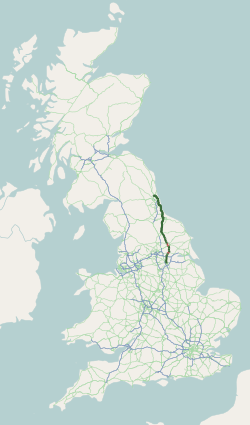
The A19 is a major road in England running approximately parallel to and east of the A1 road. Although the two roads meet at the northern end of the A19, the two roads originally met at the southern end of the A19 in Doncaster, but the old route of the A1 was changed to the A638. From Sunderland northwards, the route was formerly the A108. In the past the route was known as the East of Snaith-York-Thirsk-Stockton-on-Tees-Sunderland Trunk Road. Most traffic joins the A19, heading for Teesside, from the A168 at Dishforth Interchange.

Barlow is a small village and civil parish located in the Selby District of North Yorkshire, England, about 16 miles south of York. In the 2011 census, it had around 290 houses and a population of 753.

Wheldrake is a village and civil parish located 7 miles (11 km) south-east of York in the unitary authority of the City of York, which is in the ceremonial county of North Yorkshire, England. According to the 2001 census the parish had a population of 1,909, increasing to 2,107 at the 2011 Census.

Barkston Ash is a small village and civil parish close to Selby in North Yorkshire, England. It was formerly known as Barkston in the West Riding of Yorkshire.
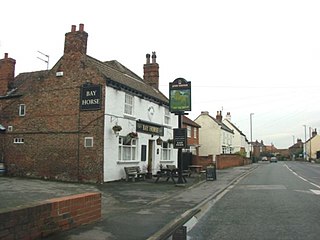
Barlby is a linear village in the civil parish of Barlby with Osgodby, in North Yorkshire, England. It is situated 2 miles (3 km) to the north-east of the market town of Selby, and is bordered to the west by the River Ouse and to the east by the A19 Barlby bypass. Across the bypass is Barlby's smaller sister village, Osgodby.

Bilbrough is a village and civil parish in the Selby District of North Yorkshire, England, 6 miles (10 km) south-west of York, and just outside the York city boundary. According to the 2001 Census it had a population of 319 increasing to 348 at the 2011 census.

Bolton Percy is a village and civil parish in the Selby District of North Yorkshire, England. According to the 2001 census it had a population of 305 in 115 households, reducing marginally to 304 at the 2011 census. The village is about 4 miles (6.4 km) east of Tadcaster.

Naburn is a small village and civil parish in the unitary authority of the City of York in the ceremonial county of North Yorkshire, England. It lies on the eastern side of the River Ouse about 4 miles (6.4 km) south of York. According to the 2001 census the parish had a population of 470, increasing to 516 at the 2011 census.
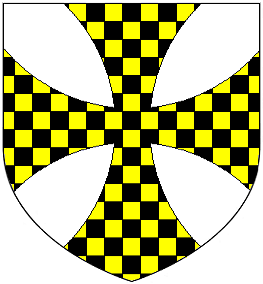
Baron Wenlock is a title that has been created three times, once in the Peerage of England and twice in the Peerage of the United Kingdom. The first creation came in 1461 when the soldier Sir John Wenlock was summoned to Parliament as Lord Wenlock. However, he was childless and on his death in 1471 the title became extinct.

Thorganby is a small village and civil parish in North Yorkshire, England. It was historically part of the East Riding of Yorkshire until 1974, but from 1974 to 2023 was in the Selby District of the shire county of North Yorkshire. In 2023 the district was abolished and North Yorkshire became a unitary authority.

Stutton is a small village in the Selby District of North Yorkshire, England, a mile south-west of Tadcaster.

Beilby Thompson was a British landowner and politician, who sat in the House of Commons from 1768 to 1796.

Paul Beilby Lawley Thompson, 1st Baron Wenlock, born Paul Beilby Lawley, was an English nobleman and Whig politician.

Kellington is a small village and civil parish in the Selby District of North Yorkshire, England, on the banks of the River Aire. Situated almost equidistant between the towns of Pontefract and Selby, the village dates back to at least the 11th century when it was listed in the Domesday Book. The semi-rural community grew in size with the advent of local mining as housing was built to accommodate the workers of nearby Kellingley Colliery.

Clifford is a village and civil parish in West Yorkshire, England. The population of the civil parish at the 2011 Census was 1,662. The village is 3 miles (4.8 km) south of Wetherby. Many of the older buildings are built of magnesian limestone.

Beilby Richard Lawley, 2nd Baron Wenlock was an English nobleman, eldest son of Paul Thompson, 1st Baron Wenlock and 8th Baronet. He succeeded in the Barony and Baronetcy and to the family estate at Escrick, Yorkshire on the death of his father in 1852.

Beilby Lawley, 3rd Baron Wenlock was a British soldier, Liberal politician and colonial administrator who was the Governor of Madras from 1891 to 1896.

Welton is a village and civil parish in the East Riding of Yorkshire, England. The parish extends to the bank of the Humber Estuary at its southern extreme, and into the Yorkshire Wolds in the northern part. The A63 road and Hull to Selby railway line both bisect the parish east–west, south of Melton and Welton.
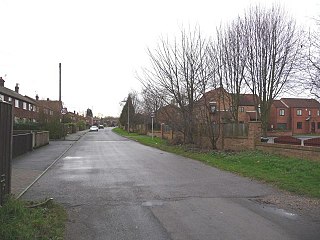
Byram is a village in the Selby District in North Yorkshire, England. It lies 3 miles (4.8 km) east of Castleford, across the River Aire in West Yorkshire. Byram is the principal settlement in the civil parish of Byram cum Sutton.
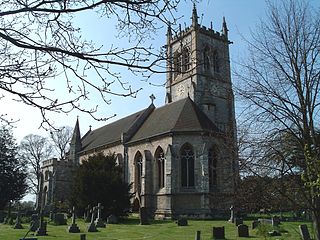
St Helen's Church is the parish church of Escrick, a village south of York, in North Yorkshire, in England.
























